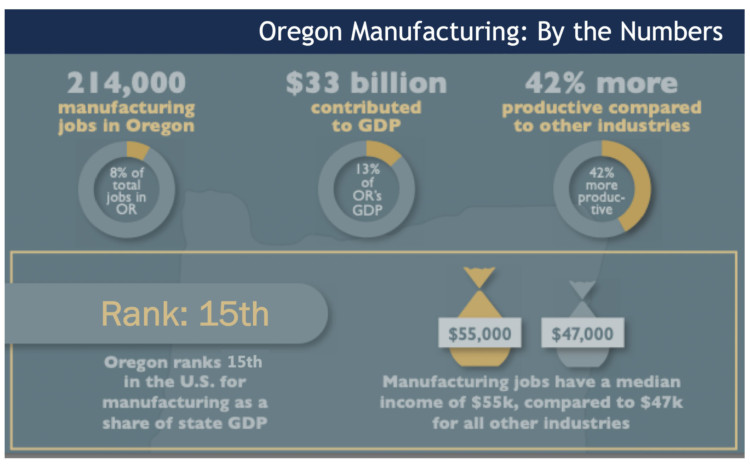
Oregon’s manufacturing sector has transitioned and grown and is positioned to take advantage of a federal effort to rebuild domestic supply chains, according to an analysis commissioned by OBI and OBC, two of the state’s leading business groups.
Conducted by ECONorthwest, the analysis shows manufacturing contributes $33 billion or 13 percent to Oregon’s GDP, employs more than 214,000 people (8 percent of total state jobs), pays on average higher wages and is spread throughout the state. For example, 35 percent of Morrow County’s total employment is in manufacturing. The comparable number is 20 percent in Yamhill County, 18 percent in Linn, Jefferson and Washington counties, 16 percent in Tillamook County and 11 percent in Josephine County.

Oregon ranks 15th among all states for its manufacturing contribution to state GDP, behind Rust Belt states such as Ohio and Michigan, but ahead of Washington, California and Texas. Manufacturing jobs in Oregon have a median annual income of $55,000, compared to $47,000 for all other industries in the state.
The most salient statistic is that Oregon has continued to grow its manufacturing sector, transitioning from timber to high tech, metals and food, while manufacturing has sharply declined nationwide. Since 1969, the baseline used in the analysis, US manufacturing employment has declined by 34 percent while Oregon’s manufacturing employment has grown by 14 percent.
Based on the same 1969 baseline, high tech electronics manufacturing has experienced the largest growth. Food and beverage manufacturing has clocked the sharpest increase starting around 2005. Metals, transportation and advanced manufacturing have registered growth despite volatile markets. Only wood products manufacturing has seen a decline. More than 5,000 Oregon manufacturers have 20 or fewer employees.
OBI and OBC commissioned the analysis because they say the “manufacturing sector is facing a historic moment” as US government and business leaders look to strengthen domestic supply chains in critical sectors such as semiconductors, pharmaceuticals, advanced machinery and food.
The groups cite President Biden’s February 24 executive order on supply chains that says: “The United States needs resilient, diverse and secure supply chains to ensure our economic prosperity and national security….Resilient American supply chains will revitalize and rebuild domestic manufacturing capacity, maintain America’s competitive edge in research and development, and create well-paying jobs. They will also support small businesses, promote prosperity, advance the fight against climate change, and encourage economic growth in communities of color and economically distressed areas.”
The ECONorthwest analysis projects a 10 percent growth rate in Oregon manufacturing would create 65,000 more jobs and generate $800 million more in state and local tax and fee revenues. The analysis says 64 percent of those new jobs would come from supply chain and consumer spending impacts. State GDP would increase by almost $9 billion and personal income would rise by $4.7 billion. To fill new jobs, Oregon’s population would need to grow by an estimated 22,000.
“The report also emphasizes,” OBI says, “that seizing these new opportunities will require focused statewide and regional strategies and reexamination of tax, regulatory and investment policies that both help and hinder the sector’s competitiveness.”
The ECONorthwest analysis broke out manufacturing sector participation and earnings by race, gender, age and educational attainment. The analysis indicates 32 percent of manufacturing employees are from the BIPOC community compared to 23 percent in all other industries. Female employees account for only 28 percent of the state’s manufacturing workforce and younger employees only 9 percent, both less than other industries.
The ECONorthwest analysis projects a 10 percent growth rate in Oregon manufacturing would create 65,000 more jobs and generate $800 million more in state and local tax and fee revenues.
Thirty percent of manufacturing employees hold at least a bachelor’s degree, comparable to the 34 percent of all other industries. Slightly more than 60 percent of manufacturing workers have some college, a high school diploma or less compared to 57 percent in other industries.
Median incomes for full-time, full-year manufacturing employees at all educational attainment levels exceed other industries. For workers without a high school diploma, manufacturing median wages are almost 17 percent higher, for workers with a high school diploma wages are 18 percent higher and for workers with associate degrees wages are 33 percent higher. The median wage gap also exists for workers with college degrees. Someone with a graduate or professional degree earns on average 65 percent more in the manufacturing sector than other industry counterparts.
Median earnings for BIPOC manufacturing workers with associate and bachelor’s degrees trends higher than white workers. BIPOC manufacturing workers at all educational attainment levels earn more on average than their counterparts in other industries.




